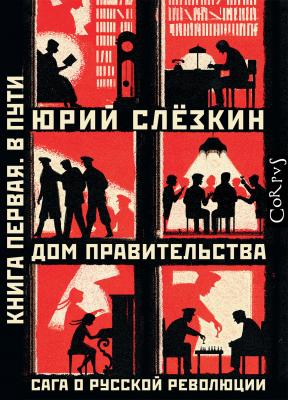ТОП просматриваемых книг сайта:















Дом правительства. Сага о русской революции. Книга первая. В пути. Юрий Слёзкин
Читать онлайн.Название Дом правительства. Сага о русской революции. Книга первая. В пути
Год выпуска 2017
isbn 978-5-17-100477-4
Автор произведения Юрий Слёзкин
Жанр Документальная литература
Издательство Corpus (АСТ)
12
Канатчиков, Из истории моего бытия, кн.1, с. 17–18.
13
Там же, с. 43.
14
Там же, с. 14, 17–18.
15
Там же, с. 11, 15–16. См. также: Robert Eugene Johnson, Peasant and Proletarian: The Working Class of Moscow in the Late Nineteenth Century (New Brunswick: Rutgers University Press, 1979); Victoria E. Bonnell, Roots of Rebellion: Workers’ Politics and Organizations in St. Petersburg and Moscow, 1990–1914 (Berkeley: University of California Press, 1983).
16
Руга и Кокорев, Москва повседневная, с. 94–98. См. также: Якиманка, с. 40; Оробей, ред., Строители России, с. 153, 181.
17
Бухарин, Времена, с. 23.
18
Оробей, ред., Строители России, с. 255–256, 261–262, 266–273, 276–280, 285–286, 293–294, 328, 360; Руга и Кокорев, Москва повседневная, с. 225, 237–238, 244, 297–318, 339–340 (о запахе цит. по с. 305); Robert W. Thurston, Liberal City, Conservative State: Moscow and Russia’s Urban Crisis, 1906–1914 (NY: Oxford University Press, 1987), с. 85–89, 154–159; Joseph Bradley, Muzhik and Muscovite: Urbanization in Late Imperial Russia (Berkeley: University of California Press, 1985), с. 299–337; Paul W. Werth, «In the State’s Embrace? Civil Acts in an Imperial Order», Kritika: Explorations in Russian and Eurasian History 7.3 (2006), с. 433–458.
19
Воспоминания о Рахманинове, т. 1, с. 125–126; Е. Дмитриевская, В. Дмитриевский, Рахманинов в Москве (M.: Московский рабочий, 1993), с. 75–76.
20
Bradley, Muzhik and Muscovite, с. 4, 9–40; Оробей, ред., Строители России, с. 29–30; Воспоминания о Рахманинове, т. 1, с. 125–126; Дмитриевская, Дмитриевский, Рахманинов в Москве, с. 75–76.
21
Thurston, Liberal City, Conservative State, с. 87; ЦИАМ, ф. 1272, оп. 1, д. 345–358 (о коммерческих учреждениях цит. по д. 358); ф. 475, оп. 19, д. 167, 167, 168; оп. 17, д. 1312, л. 3–39. См. также: Jonathan W. Daly, The Watchful State: Security Police and Opposition in Russia, 1906–1917 (DeKalb: Northern Illinois University Press, 2004).
22
И. Спиридонов, Всероссийская политическая стачка в октябре 1905 г. (М.: Госполитиздат, 1955), с. 51–52, 57; Laura Engelstein, Moscow, 1905: Working-Class Organization and Political Conflict (Stanford: Stanford University Press, 1982), с. 85–86, 110, 206–208, 214; Кондратьева и Невзорова, ред., Из истории фабрик и заводов, с. 164, 172, 176; Евсенин, От фабриканта к Красному Октябрю, с. 26–34, 38–47 (о Варфоломеевской ночи цит. по с. 28); Eric Lohr, Nationalizing the Russian Empire: The Campaign against Enemy Aliens during World War I (Cambridge: Harvard University Press, 2003), с. 16, 34. О наводнении см. материалы ЦИАМ после 1908 г., ф. 179, оп. 62, 63.
23
Christine D. Worobec, «Miraculous Healings,» in Mark D. Stenberg and Heather D. Coleman, ed., Sacred Stories: Religion and Spirituality in Modern Russia (Bloomington: Indiana University Press, 2007), с. 22–43; Roy R. Robson, «Transforming Solovki: Pilgrim Narratives, Modernization, and Late Imperial Monastic Life» в: Stenberg and Coleman, ed., Sacred Stories, с. 44–60; Mark D. Steinberg, Proletarian Imagination: Self, Modernity, and the Sacred in Russia, 1910–1925 (Ithaca: Cornell University Press, 2002), с. 224–246; Nadieszda Kizenko, A Prodigal Saint: Father John of Kronstadt and the Russian People (University Park, PA: The Pennsylvania State University Press, 2000), с. 196–200 и passim; Vera Shevzov, Russian Orthodoxy on the Eve of Revolution (Oxford: Oxford University Press, 2004); Gregory Freeze, «Subvesive Piety: Religion and the Political Crisis in Late Imperial Russia», Journal of Modern History 68 (June 1996), с. 308–350; Heather J. Coleman, Russian Baptists and Spiritual Revolution, 1905–1929 (Bloomington: Indiana University Press, 2005), с. 41–60 и passim; A. Эткинд, Хлыст. Секты, литература и революция (M.: НЛО, 1998); Olga Matich, Erotic Utopia: The Decadent Imagination in Russia’s Fin de Siècle (Madison: The University of Wisconsin Press, 2005), с. 9–10 (строка о «последних в ряду» по Вячеславу Иванову цит. по с. 3); Irina Paperno, «Introduction» и «The Meaning of Art: Symbolist Theories» в: Irina Paperno and Joan Delaney Grossman, ed., Creating Life: The Aesthetic Utopia of Russian Modernism (Stanford: Stanford University Press, 1994), с. 1–23; В. Соловьев, Собрание сочинений (Ст. П. 1911–1914), т. 6, с. 85. См. также: David M. Bethea, The Shape of Apocalypse in Modern Russian Fiction (Princeton: Princeton University Press, 1989); Irene Masing-Delic, Abolishing Death: A Salvation Myth of Russian Twentieth-Century Literature (Stanford: Stanford University Press, 1992); Christopher Read, Religion, Revolution and the Russian Intelligentsia 1900–1912 (London: Macmillan, 1979); Laura Engelstein, Castration and the Heavenly Kingdom (Ithaca: Cornell University Press, 1999); Mark D. Steinberg, Petersburg Fin de Siècle (New Haven: Yale University Press, 2011), с. 234–267; Robert C. Williams, «The Russian Revolution and the End of Time: 1900–1940», Jahrbücher für Geschichte Osteuropas 43, No. 3 (1995), с. 364–401.
24
Н. Бухарин, Времена, с. 179–180; А. Воронский, За живой и мертвой водой, т. 2 (М.: Антиква, 2005), с. 202, 222–234,

